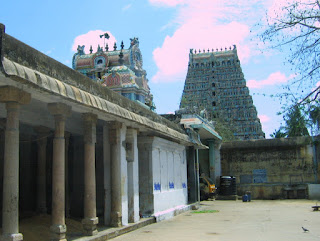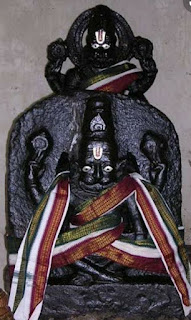Kapali temple plans large scale demolition of residential houses on Kumara Gurunathan Street, Residents shocked
Any new and modern construction around the Kapali Temple will go against the heritage and aesthetics of the Kapali temple environ.Temple Activist TR Ramesh plans to file Writ Petition against the Demolition
Residents worried if High Rise Business Complexes will come up on the streets around the Templex
It has been a pretty tense week for residents in four streets around the Sri Kapaleeswarar Temple. The latest plan to completely demolish all old traditional construction and build new complexes has sent shock waves especially among the residents of Kumara Gurunathan Street, just South of the Kapali Temple. They were called in for a meeting at the Kapali temple earlier this week where they were categorically told to vacate the houses within the next month. There were no discussions and plans, only a direction to vacate. No compensation will be paid to any of the residents and they will have to find their own houses. While most of them are former service personnel, now retired, there are a few current serving staffers of the temple who are residents of this street.
60 Families to be Dislocated
Most of them have been living here for several decades. The entire street has been a set of row houses. The temple is looking at complete reconstruction work in four streets around the temple complex – Ponnambala Vadhyar Street, East Tank Square Street, Pichupillai Street and Kumara Gurunathan Street.
While the temple has plans to build a car park, toilets, rest houses, quarters for staff and a mini Kalyana Mandapam, the residents point to the examples on the Mada Streets and say that they would not be surprised if high rise buildings especially business complexes, are constructed on this street.
70 years of Parichaka Service
75 year old D Narasimhan was a Paricharaka at the Sri Kapaleeswarar for four decades. His father had been serving at the temple for many decades prior to that. Now the third generation - Narasimhan’s nephew- is performing service at the temple. Narasimhan’s son Hari, who is a Purohit, says that their forefathers had been living on the Kumara Gurunathan street for 70years “Around 1960, they built the small around 700 sq ft hut house for them. In the last six decades, there has not been a single renovation organised by the temple at this house. The entire expense relating to the house has been undertaken by us.”
“They have asked us to vacate in one month- a place where we have paid the rent that they have fixed even though not one repair work has been done by the owner of the house in 60years. They have said that they we can take a house on rent when it comes for auction in the temple owned lands in and around Mylapore. But as one has seen, almost all the auctioned properties in the past have been picked up only by non service personnel and there have never been cases where temple service personnel have been able to pick up properties in temple auctions as the initial deposit and base price is fixed high.”
Historically, lands were given to temples, originally by kings and later by high profile people, to provide housing for the service personnel and to take care of them through their lifetime. As this section had pointed out in January 2020 in a story, the Poonamallee Vellalar Community had donated several properties to the temple few centuries ago. It was with the rental income from these properties that Utsavams were organised. Not just here in Mylapore, they had also donated a house on Thirupalli Street in Georgetown in North Madras for the conduct of the Theppotsavam and Panguni Utsavam at the Kapaleeswarar temple. The welfare of the priests and the service personnel too were to be taken care of.
“My forefathers worked for several decades at a low wage almost as a selfless service to Lord Kapaleeswarar. My father is now 75years old and he is now living on a knife edge not knowing how to react to this” says Hari.
Banks reject Home Loans to Paricharakas
A few yards away from his father Narasimhan’s house is a small 1 bed room house of another Paricharakar, the 63year old Ramakrishnan who joined the temple in 1978 and retired a few years ago after having served for four decades at the Kapali Temple. He too has now been asked to vacate in the next month. “We have lived here for several decades serving the Lord. Our salary was so low in those days that banks refused housing loans to us. Hence we could not afford to construct even a small house of our own. Now if we are asked to go away without any compensation or an alternate housing facility, where can we go.”
Precendents point to a High Rise Business Complex
The worry of the residents is also that while the temple is talking about providing quarters to its current staff, it is likely that high rise modern constructions could come up on this street. They point to BLT stores building a high rise 100yards away from the temple in a location where there was a 100 year old traditional house in the not too distant past. They say that all the old buildings are going away. They also point out that the parking in the entire North Mada street has been taken over by the shops including opposite the temple office and that the temple has not been able to do anything with that.
73 year old Velayudham is the former Maniya Kaarar of the Kapali Temple. He too served there for over four decades and lived almost all his life performing temple service. “Ever since the visit of the minister and the EO, we have been mentally stressed. We did all the renovation work relating to the house over the last four decades. There are 30 houses of Kapali Temple opposite the Saibaba Temple and another close to 40 houses opposite the PS School. All these were allocated in those decades for service personnel – current and former- of the temple. If we are provided replacement house to live in, we can spend the remaining years of our life in peace. Else, it is going to be a struggle for us trying to find another house and paying a high rent for that place.”
Sath Gurunathan Othuvar too lives in a house on Kumara Gurunathan Street. He has been at the temple for over two decades. While the temple offered a place to stay at that time, it had become dilapidated over time given that most of these houses were built six decades earlier and no improvements had been done by the temple during that period. Through the support of devotees, he renovated his house and spent in lakhs to improve the facilities. As part of this exercise it is likely he too will have to vacate after having spent a lot of money on the renovation but since he is a current staffer and has several years of service left, he may be provided an alternate housing facility.
KAPALI OTHUVAR'S HOUSE GURUNATHAN STREETMylapore based temple activist TR Ramesh(https://prtraveller.blogspot.com/2018/02/tr-ramesh-temple-activist.html), who is the President of the Temple Worshippers Society has filed several cases against the Kapaleeswarar temple including the validity of the appointment of the EO. He says that he will file a Writ Petition in the Madras HC against the demolition of buildings around the temple complex. He says that there is no order appointing EO of Kapali temple that has ever been issued and the Government did not deny this at the High court in October 2020. Hence the EO has no locus standi to direct demolition of the buildings. He has also questioned the term of the Thakkar ( 90days period now extending to 9years!!!) Also this temple was established by Poonnamalee Mudaliar and there has to be a trustee from among them
Over three Centuries ago, when the Kapaleeswarar temple was being built in its current location, the Thuluva Velalar community had a significant role to play in its development. 82 year old AC Kandaswamy, a Civil Engineer, is now the President of the Poonamalee Uyir Thuluva Vellalar Marabinar Sangam that was officially registered in 1946 once the HR & CE took over the temple. He recounts the role of his forefathers in the development and improvement of the temple over the last few centuries “Mylai Naattu Muthaiappa Mudhaliar donated lands for the temple 380 years ago. Several members of the community made large donations in the form of jewels and house properties for the maintenance of the temple and the Service Personnel.”
This section had featured a story in January 2020 on the role of the Vellala community and their contribution to the development of the Kapaleeswarar temple. Even after the HR & CE took over, three members of the Thulu Vellala community were appointed as trustees and this went on till 1976. And then all of a sudden, no members were appointed from the community.
Mylapore as a Heritage Locations
More importantly, he says that Mylapore is already in the radar for being declared as heritage place and the status in question pertains to buildings in and around Kapali temple. Any new and modern construction around the Kapali Temple will go against the heritage and aesthetics of the Kapali temple environ.
Finally, under the HR & CE act, rules have been framed only for preservation and maintenance of temple properties. There cannot be demolition or new construction especially of those that have heritage value.
He says that the Commissioner has necessarily to consult ASI. In September 2013, the TN Government had passed a GO by which all civil works impinging on a monument around historical temples shall be done as per the Venice Chapter, which says no new settings should be brought in even while conservation. If so no large scale demolition can happen around the temple complex. If they go ahead with this, the Government would be violating its own GO, the Venice chapter subscribed by GOI and Section 118(2) (XIX and XX1) of HRCE Act 1959.
This section will track the developments around the Kapaleeswarar Temple.
































